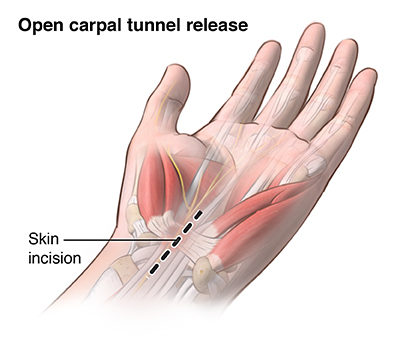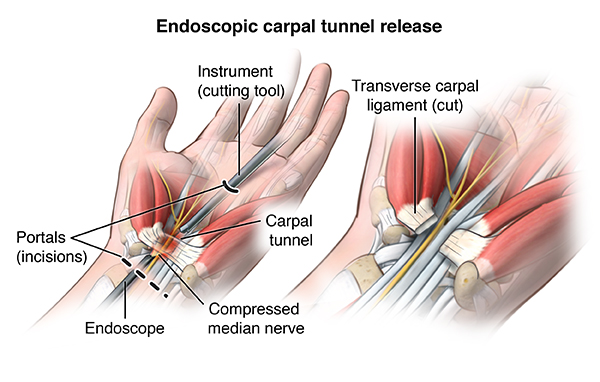
Carpal tunnel surgery is performed to treat carpal tunnel syndrome, also known as median nerve compression. This a painful medical condition that causes numbness, tingling, or weakness in the affected hand.
Carpal tunnel syndrome is a congenital predisposition. Injuries like fracture or sprain, or even overusing a vibrating tool can cause this condition. In some studies, it is found to be associated with diabetes, pregnancy, rheumatoid arthritis, and thyroid disease.
Once the diagnosis is confirmed with nerve conduction studies, surgery is performed to relieve the symptoms and signs of carpal tunnel syndrome. Patients with mild symptoms of carpal tunnel syndrome can try non-surgical treatment options before carpal tunnel surgery. Such management options may be physical therapy, over-the-counter pain medications, alterations to some of the equipment used at the workplace, shots of steroids in the wrist, or wrist splints to help alleviate pain and swelling.
Following are some of the factors that indicate to undergo a carpal tunnel surgery:
Carpal tunnel release surgery is generally performed in an outpatient setting. This means the patient can go back home the same day. The procedure is usually done under a local anaesthetic.
There are two types of carpal tunnel surgery:
This is a well established technique where a small incision is made on the palm and the transverse carpal ligament is divided to release the median nerve . This surgery is done under magnification by using surgical loupes.

In this procedure, the surgeon makes 2 half-inch incisions on the patient’s wrist. From one incision, a flexible, thin tube containing a camera is put into the patient’s wrist. The camera assists the treating surgeon as the carpal tunnel surgery is performed with the help of thin instruments put into the patient’s wrist through the other tiny incision.

After treating the affected area, the surgeon closes the incisions with sutures. The hand and wrist of the patient will be bandaged or placed in a splint to restrict any movements. The patient will be kept under observation for a short time after the surgery, and then is allowed to go back home. Only in some complications or rare scenarios will the patient need overnight hospitalisation after carpal tunnel surgery.
With any surgery there are generally associated risks and complications. The following are some of the risks related to carpal tunnel syndrome:
The recovery period after carpal tunnel surgery is usually a few weeks. The recovery period may take longer if the median nerve has been compressed for a long time. The recovery process includes splinting the patient’s wrist and later getting physical therapy. Starting after at least one week, physical therapy helps to heal and strengthen the hands and wrists.
After the carpal tunnel surgery, the patient should take care of the following:
Carpal tunnel surgery has a very high success rate of more than 90%. Most of the symptoms such as waking up at night, discomfort, and tingling sensation in the hands are quickly relieved post-treatment. It may take around 3 months for the numbness to get better.
The extent of recovery of power and sensation will also depend of the duration and severity of symptoms.
It is advised to wear a wrist brace or a splint for few weeks post-carpal tunnel surgery.
Yes, in the early stages of symptoms, carpal tunnel syndrome can be fixed without surgery. Non surgical management includes avoiding precipitating factors, use of hand splints, hand physiotherapy and trial of steroid injection.
The recurrence of carpal tunnel symptoms even after the surgery is possible due to scarring . The recurrence rate varies from 3% to 25%. The results after the second surgery are variable with reports demonstrating persistent symptoms in up to 95% of the patients.
No, the hand and wrist of the patient will be bandaged heavily or placed in a splint to restrict any movements.
The procedure takes around 15 minutes to complete.
If a patient undergoes surgery on the dominant hand and does repeated movements at work, then the patient may be able to return to work in 2-3 weeks. Repeated actions such as typing or using heavy machinery are best avoided in the initial return to work.
Most patients can drive two weeks after surgery.
Carpal tunnel surgery is commonly performed by a trained neurosurgeon, plastic surgeon or orthopaedic hand surgeon.
Carpal tunnel surgery can be easily done under the effect of local anaesthesia. This means the patient is awake and only the area being treated is numbed.
It can however be done under a short general anaesthetic if the patient is very anxious or prefers not to be awake during surgery.